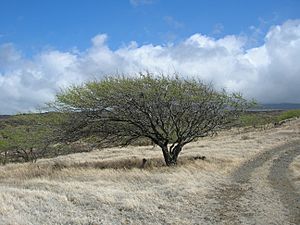Prosopis pallida facts for kids
Quick facts for kids Prosopis pallida |
|
|---|---|
 |
|
| Scientific classification | |
| Synonyms | |
Prosopis pallida is a type of tree known by many names. In Hawaii, people call it kiawe. In its home, South America, it's called huarango. Some also call it the "American carob." This tree has thorns and belongs to the legume family. It grows naturally in dry areas near the coast in Colombia, Ecuador, and Peru. Even though it's struggling in its native lands, it's considered an invasive species in many other places.
Contents
What the Kiawe Tree Looks Like
The kiawe tree can be a wide bush or a medium-sized tree. It has sharp spines on its branches. Its flowers are greenish-yellow and grow in spikes. The tree also produces long pods filled with small brown seeds.
How Kiawe Spreads and Survives
The kiawe is very good at spreading. It makes many seeds that can travel easily. It can also grow new plants from its roots. This forms thick groups that block sunlight for other plants.
Kiawe trees have a very long taproot. This root can reach deep water underground. This helps them survive in dry places where other plants can't. They are so good at finding water that they can even take water away from nearby plants. They can grow in tough spots like sandy slopes, salty soils, or rocky cliffs.
Uses of the Kiawe Tree
This tree grows quickly and can live for more than a thousand years. It makes a good shade tree, but watch out for its sharp thorns on fallen branches! Its hard wood is great for long-burning firewood and charcoal.
Food and Honey from Kiawe
Kiawe pods can be used as food for livestock. They can also be ground into flour, made into molasses, or used to make beer. The tree's light yellow flowers attract bees. These bees make a special white honey from the flowers, which many people like.
Kiawe as an Invasive Species
Fallen kiawe branches often have sharp spines. These can puncture both feet and tires.
The tree was sometimes planted to replace forests and stop erosion. Once it grew, it often took over the area. It was brought to Puerto Rico and Hawaii, as well as parts of Australia. Now, it grows naturally in these places. The first kiawe was planted in Hawaii in 1828. Today, it's a common shade tree and a widespread weed on the Hawaiian Islands. However, it still provides firewood for heating and cooking there.
Kiawe and Ancient Cultures
Some scientists think that cutting down too many kiawe (huarango) trees was a big reason for the fall of the Nazca culture in southern Peru. This happened around the 6th century AD. After a big El Niño event, there was flooding, erosion, and the land became a desert. The loss of the huarango trees made these problems worse.
Protecting the Huarango Tree
Scientists believe the huarango is very important for the desert ecosystem in southern Peru. It helps keep moisture in the ground and prevents erosion. Even though local rules forbid it, poor villagers still cut down these trees to make charcoal. People are now working to plant more huarango trees in the area.
Different Types of Kiawe Trees
In southwest Ecuador, Prosopis pallida and another similar tree, Prosopis juliflora, have many differences within their own species. This is because their flowers cross-pollinate easily. So, trees of one species can look like the other, and they are often confused. These two species can also create hybrid trees where they grow near each other.
In a dry area of Ecuador called Zapotillo Canton, you can find both thorny and thornless Prosopis pallida trees. The thorny ones are more common. Local people prefer this tree for making charcoal. Sometimes, it's also cut for firewood or fence posts.
History
The first kiawe tree in Hawaii was planted in 1828. It grew from a seed brought by a missionary named Alexis Bachelot from the Palais-Royal Gardens.
Images for kids
See also
 In Spanish: Algarrobo pálido para niños
In Spanish: Algarrobo pálido para niños









